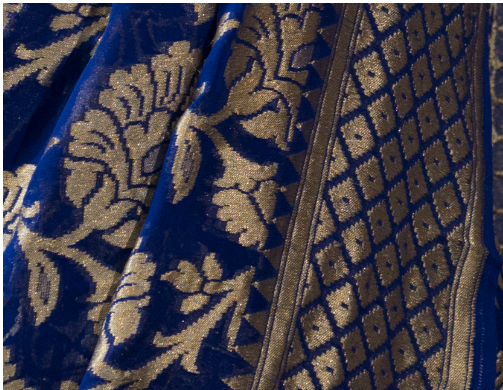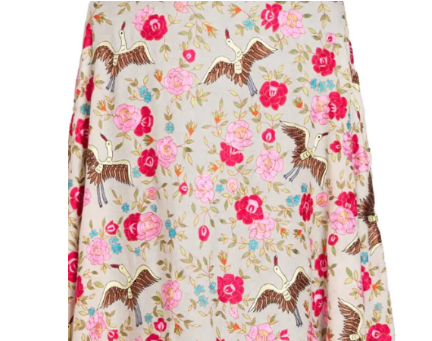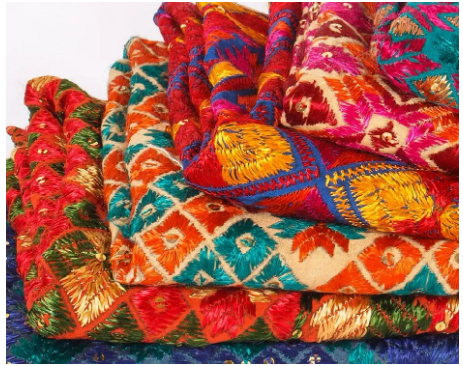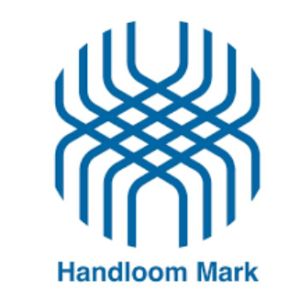India’s Rich Heritage Textiles: Sustainable Fashion Alternatives
India’s heritage textiles are a rich tapestry of history, culture, and craftsmanship, showcasing unique techniques and styles from various regions.

Banarasi Silk Sarees from Varanasi are famous for their intricate brocade work and luxurious feel, often adorned with gold and silver threads. Gujarat’s Bandhani Textiles captivate with their vibrant tie-dye patterns, reflecting meticulous craftsmanship and vibrant aesthetics.

In Kashmir, the delicate Pashmina Shawls are handwoven from the finest wool, offering unmatched warmth and elegance. Tamil Nadu’s Kanchipuram Silks are celebrated for their rich colors and bold patterns, featuring intricate temple borders and motifs.

From the Phulkari Embroidery of Punjab, with its vivid floral designs, to the Dabu Block Printing of Rajasthan, using natural dyes and eco-friendly techniques, each textile tells a unique story. These textiles are not just fabrics; they are centuries-old narratives preserving India’s cultural heritage and providing sustainable alternatives to fast fashion.
“Heritage textiles are more than just fabric; they are the legacy of centuries-old craftsmanship that is being eroded by the rise of unsustainable, fast fashion.” – UNESCO
The Impact of Fast Fashion on People, Planet, and Prosperity
Fast fashion’s significant impact on climate change and environmental pollution makes it imperative to promote sustainable alternatives. The fashion industry contributes 10% of global carbon emissions, more than international flights and maritime shipping combined. Polyester production, common in fast fashion, emits nearly three times more CO2 than cotton. Textile production is the second-largest consumer of water globally, with a single cotton shirt requiring about 2,700 liters of water. Fast fashion’s dyeing processes contribute to 20% of global industrial water pollution, releasing toxic chemicals into water sources. The industry generates massive waste, with 92 million tonnes of textile waste annually, expected to reach 134 million tonnes by 2030. Synthetic fabrics release microplastics during washing, contributing 35% of ocean microplastic pollution. The energy-intensive nature of fast fashion, requiring around 1,500 TWh annually, predominantly relies on non-renewable sources.
“Every year, half a million tons of plastic microfibers, equivalent to 50 billion plastic bottles, are
released into the ocean as a result of washing synthetic textiles.” – Ellen MacArthur Foundation
Heritage Textiles Face Existential Threats from Counterfeit Products
“Counterfeit and fast fashion textiles contribute significantly to environmental degradation. By
choosing authentic heritage textiles, we can reduce pollution, conserve resources, and promote
sustainable practices.” – Greenpeace India
Counterfeit products, like fake Banarasi sarees, devastate weavers, harm the local environment, and threaten India’s long-term prosperity. Approximately 4.3 million handloom weavers in India are directly impacted, with incomes falling by 30-40% due to cheap imitations. These counterfeit sarees, often produced in sweatshops, exploit labor and diminish the value of authentic craftsmanship.
Environmental damage is significant. The textile industry is the second-largest polluter globally, and counterfeit production exacerbates this by using harmful dyesand chemicals. Studies indicate that textile dyeing accounts for 20% of global industrial water pollution, harming local ecosystems and communities.
“The counterfeit market not only devalues the authentic heritage textiles but also threatens
the socio-economic fabric of artisan communities, leading to a decline in traditional skills and
cultural heritage.” – Textiles Ministry, Government of India
“The proliferation of counterfeit heritage textiles is not only an economic threat but also a
cultural one, eroding the value of authentic craftsmanship and leading to the decline of
traditional skills.” – Craft Revival Trust
Economically, the counterfeit market costs India’s textile sector an estimated $2.7 billion annually. This undermines the country’s cultural heritage, weakens consumer trust, and disrupts traditional markets. The loss of authenticity in heritage textiles threatens the socio-economic fabric of communities and hampers sustainable
development, jeopardizing India’s cultural and economic future.
Tri-Impact Global’s Commitment to Heritage Textiles
Tri-Impact Global supports heritage textiles as a sustainable alternative to fast fashion. We initiate awareness campaigns to educate consumers about the benefits of heritage textiles and the negative impacts of fast fashion. By promoting authenticity and helping consumers recognize genuine heritage textiles through certifications like silk marks and handloom marks, we combat the threat of counterfeit products.
We foster collaborations with designers, influencers, and sustainability advocates to amplify the visibility and desirability of heritage textiles. Additionally, we facilitate direct connections between producers and consumers, ensuring fair trade practices and better livelihoods for artisans.
Key Objectives of the Program:
- Promoting natural fibers.
- Ensuring the welfare of producers.
- Reviving heritage textiles.
- Educating the public about recognizing authentic products.
Program activities to support Heritage Textiles:
- Spread awareness of different Heritage textiles, their significance, and cultural and historical values.
- Influence consumers to change their preference from fast fashion to more sustainable and durable heritage textiles.
- Make consumers aware about counterfeit products and how should they distinguish between genuine and counterfeit heritage textiles.
Enhancing India’s Efforts to Combat Counterfeit Textiles
“Certification programs such as the Silk Mark and Handloom Mark are vital in ensuring the
authenticity and quality of heritage textiles. They empower consumers to make informed choices
and support genuine artisans.” – Silk Mark Organisation of India
Support government-issued certifications and labels. Spread information about these certifications among the consumers. Encourage artisans and micro-entrepreneurs to make best use of government certifications that help identify as product as genuine heritage textiles.
Building Awareness: Many artisans and consumers are unaware of the benefits of GI Tagging, Silk Mark, and Handloom Mark. Insufficient promotion leads to limited public recognition and demand for authentic products.
“Geographical Indication tags play a crucial role in protecting the unique identity of our heritage
textiles, ensuring that only genuine products are marketed under these esteemed names.” –
World Intellectual Property Organization (WIPO)
 GI tagging: A geographical indication (GI) is a sign used on products that have a specific geographical origin and possess qualities or a reputation that are due to that origin. Banarasi Sarees, Kanchipuram Sarees, Orissa Ikat, etc are all examples of heritage textiles that are GI tagged.
GI tagging: A geographical indication (GI) is a sign used on products that have a specific geographical origin and possess qualities or a reputation that are due to that origin. Banarasi Sarees, Kanchipuram Sarees, Orissa Ikat, etc are all examples of heritage textiles that are GI tagged.

Handloom Mark: Handloom Mark is the Government of India’s initiative to provide a collective identity to the handloom products in India and can be used not only for popularizing the hand-woven products but can also serve as guarantee for the buyer that the product being purchased is genuinely hand woven in India. The Handloom Mark is aimed to promote the brand of handlooms and develop a niche market for the handloom textiles with a distinct identity. The Mark is also a symbol of social cause to promote the live welfare, and growth of more than 6.5 million weavers.

Silk Mark: Silk Mark is a certification mark in India for silk textiles. The mark certifies that the piece of textile which bears the mark is made of pure natural silk. The certification is managed by the ‘Silk Mark Organisation of India’, a society set up by the state- controlled Central Silk Board of India.
“Certification programs such as the Silk Mark and Handloom Mark are vital in ensuring the
authenticity and quality of heritage textiles. They empower consumers to make informed choices
and support genuine artisans.” – Silk Mark Organisation of India
Improving Enforcement: Weak regulatory mechanisms allow counterfeit products to flood the market. Inadequate monitoring and punitive measures undermine the effectiveness of these initiatives.
Reducing Costs and Bureaucratic Hurdles: The GI registration process is expensive and complex, deterring many small-scale producers. Administrative procedures are cumbersome, causing delays and frustration.
Insufficient Support for Artisans: Limited access to quality raw materials, modern tools, and training hampers artisans’ ability to compete. Financial support and incentives for engaging in GI registration and maintaining traditional methods are lacking.
Marketing Improvements and Branding: Ineffective marketing strategies fail to promote GI-tagged products effectively. Heritage textiles face stiff competition from cheap, mass-produced fast fashion items.
Coordinated Efforts to Meet International Challenges: Lack of coordination among stakeholders leads to fragmented efforts. Gaining international recognition and enforcement for Indian GI tags is challenging, limiting global market protection.
Global Examples of Combating Counterfeit Textiles
Italy:
- Geographical Indications (GI): The “Made in Italy” label protects textiles produced in specific regions using traditional methods.
- Consortiums and Certification Marks: The Consortium for the Protection of Cashmere maintains high standards and authenticates products.
France:
- Labeling and Traceability: The “Entreprise du Patrimoine Vivant” (Living Heritage Company) label certifies traditional craftsmanship.
- Legal Framework: Stringent laws and dedicated customs units monitor and seize counterfeit goods.
Japan:
- Cultural Branding and Promotion: Initiatives promote heritage textiles like Nishijin-ori silk and Kyo-yuzen dyeing.
- Technological Integration: Blockchain ensures the traceability and authenticity of heritage textiles.
Tri-Impact partners with Hyundai Foundation to protect the interest of Artists and Heritage Textiles vide their “Art for Hope” Program
In the Art for Hope Program sponsored by Hyundai Foundation, Tri-Impact illuminated the profound narrative of Banarasi silk sarees, a gem of Indian heritage fashion. Handwoven with dedication in Varanasi, these sarees are renowned for their natural fibers, meticulous patterns, and enduring quality, celebrated through a coveted Geographical Indication (GI) tag. Despite their international acclaim, the economic reality for the artisans behind these masterpieces is starkly different. The weavers struggle to secure a sustainable income, endangering both their livelihoods and the survival of their art.
The challenge of authenticity verification—confirming the silk quality, design intricacy, handloom craftsmanship, and true origin of each saree—is at the heart of the crisis. Counterfeit products easily permeate the market, undercutting genuine artisans and diluting the revered brand of Banarasi sarees.
Recognizing the urgent need for intervention, Tri-Impact Global’s initiative extends beyond mere preservation. It aims to redefine consumer perceptions, advocating for sustainable fashion by stressing the environmental, cultural, and historical importance of heritage textiles. This shift is crucial not only for environmental conservation but also for sustaining the cultural legacy embedded in each thread of Banarasi silk.
Tri-Impact’s approach embraces the principles of People, Planet, and Prosperity to ensure weavers’ well-being and enhance their creations’ visibility and viability. This comprehensive effort involves rigorous research, stakeholder collaboration, and innovative strategies to connect tradition with contemporary values, focusing on eco- conscious and culturally respectful practices.
By implementing measures such as government-backed Silk Marks and unique QR codes, Tri-Impact empowers consumers to make informed choices, directly supporting the artisans and preserving this precious art form.
In this era where sustainable clothing choices are pivotal, the Art for Hope Program stands as a beacon of change, striving to secure a thriving future for Banarasi saree weavers and their timeless craft.
“The fashion industry is built on the exploitation of labor, and the insatiable demand for cheap
clothes is leading to significant human rights abuses.” – Human Rights Watch
